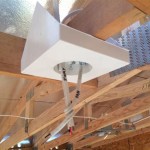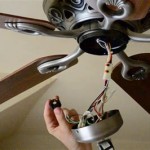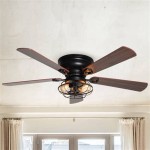How to Measure the Size of a Ceiling Fan
Determining the appropriate size of a ceiling fan for a given room is crucial for optimal airflow and energy efficiency. A fan that is too small will not circulate air effectively, leaving areas of the room stagnant and uncomfortable. Conversely, a fan that is too large can create excessive drafts and may be visually overwhelming in the space. This article provides a comprehensive guide on how to accurately measure the size of a ceiling fan and select the appropriate fan size based on the room's dimensions.
The primary measurement used to define the size of a ceiling fan is its blade span. The blade span is the diameter of the circle that the fan blades create when rotating. Understanding how to accurately measure this dimension, in conjunction with the room's square footage, is essential for making an informed decision about fan selection.
Measuring the Blade Span of an Existing Ceiling Fan
If the intent is to replace an existing ceiling fan, measuring the blade span of the current fan is a straightforward process. However, care must be taken to ensure accurate measurements are obtained.
Begin by ensuring the ceiling fan is switched off and, ideally, disconnected from the power source for safety. While not always necessary, this precaution eliminates the risk of accidental activation during the measurement process.
Using a measuring tape, extend the tape from the tip of one blade, across the center of the fan's motor housing, to the tip of the blade directly opposite. This measurement represents the diameter, or blade span, of the fan. It is important to ensure the measuring tape runs precisely through the center of the motor housing to obtain an accurate reading. Minor deviations can lead to errors in the overall measurement.
In cases where the blades are curved or angled, take the measurement at the point where the blade extends the furthest from the center. This will provide the most accurate representation of the fan's overall reach.
If access to the fan is difficult, such as when it is mounted on a high ceiling, consider using a ladder or step stool to bring the fan within easy reach. Prioritize safety and ensure the ladder or step stool is stable and securely positioned before commencing the measurement.
Record the measurement in inches. This measurement will be used to determine the appropriate replacement fan size based on the room's dimensions, as discussed in subsequent sections.
Determining the Appropriate Fan Size Based on Room Size
Selecting the right ceiling fan size based on the room's square footage is crucial for optimal performance. A general guideline exists that correlates room size with appropriate fan blade span.
First, calculate the square footage of the room. To do this, measure the length and width of the room in feet and multiply these two values together. For example, a room that is 12 feet long and 10 feet wide has a square footage of 120 square feet (12 ft x 10 ft = 120 sq ft).
Once the square footage is known, the following guidelines can be used to determine the appropriate fan size:
- Rooms up to 75 square feet: Consider a ceiling fan with a blade span of 36 inches or less. These smaller fans are suitable for very small rooms such as bathrooms, closets, or small home offices.
- Rooms between 76 and 144 square feet: Opt for a ceiling fan with a blade span of 42 to 48 inches. This size is appropriate for small to medium-sized bedrooms, kitchens, or dining areas.
- Rooms between 144 and 225 square feet: A ceiling fan with a blade span of 50 to 54 inches is typically recommended. This size is well-suited for larger bedrooms, living rooms, or family rooms.
- Rooms larger than 225 square feet: For very large rooms, consider a ceiling fan with a blade span of 56 inches or larger. Alternatively, in extremely large spaces, multiple ceiling fans may be necessary to ensure adequate air circulation.
These guidelines provide a starting point for selecting the appropriate fan size. However, other factors such as ceiling height and room shape should also be considered. For rooms with high ceilings (over 9 feet), a downrod may be required to lower the fan to an optimal height for air circulation. Irregularly shaped rooms may also benefit from a slightly larger fan than the guidelines suggest to ensure adequate coverage.
Other Considerations Influencing Fan Size Selection
While room size is the primary factor in determining appropriate ceiling fan size, several other considerations can influence the final selection. These factors include ceiling height, room usage, and personal preferences.
Ceiling Height: As mentioned previously, ceiling height plays a significant role in fan performance. For ceilings higher than 9 feet, a downrod is typically recommended. A downrod is an extension pole that lowers the fan from the ceiling, bringing it closer to the floor and improving air circulation. The appropriate downrod length depends on the ceiling height. Generally, the bottom of the fan blades should be between 7 and 9 feet from the floor. Consult a downrod length chart or a ceiling fan expert for specific recommendations based on ceiling height.
Room Usage: The intended use of the room can also influence fan size selection. For example, a bedroom may benefit from a slightly smaller fan with quieter operation, while a living room or family room may require a larger fan with more powerful airflow. Kitchens may also benefit from fans with features like damp ratings, enabling them to withstand higher humidity levels.
Personal Preferences: Personal preferences regarding aesthetics and airflow can also play a role in fan selection. Some individuals prefer a more subtle airflow, while others prefer a stronger breeze. Adjusting the fan speed can partially address this, but selecting a fan with appropriate blade pitch and motor power can also contribute to achieving the desired airflow. Blade pitch refers to the angle of the fan blades, which affects the amount of air moved with each rotation. Motors with higher wattage ratings generally provide more powerful airflow.
Fan Location: For rooms with unusual layouts, consider the placement of the fan carefully. In long, narrow rooms, consider installing two smaller fans instead of one large fan to ensure more even air distribution. In rooms with obstructions, such as furniture or partitions, position the fan to maximize airflow around these obstacles. Multiple fans can also provide better air circulation in larger rooms with complex layouts.
Energy Efficiency: When selecting a ceiling fan, consider its energy efficiency rating. Look for fans with the Energy Star label, which indicates that the fan meets specific energy efficiency standards. Energy Star-certified fans typically use less energy than standard fans, resulting in lower operating costs over time. Pay attention to the fan's wattage rating and airflow (CFM - cubic feet per minute) to assess its energy efficiency. A higher CFM per watt rating indicates a more energy-efficient fan.
Fan Features: Consider additional features that may be desirable, such as remote controls, light kits, and variable speed settings. Remote controls provide convenient control over fan speed and lighting, while light kits can add functionality to the fan. Variable speed settings allow for customization of airflow to suit different preferences and needs. Some fans also offer reversible motor functionality, which allows the fan to be used for both cooling in the summer and circulating warm air in the winter.
By carefully considering room size, ceiling height, room usage, personal preferences, and energy efficiency, an informed decision can be made about the appropriate ceiling fan size for any given space. Accurately measuring the blade span of existing fans or understanding how to correlate room square footage with appropriate fan size is paramount to achieving optimal airflow and comfort.

How To Measure A Ceiling Fan Hunter

Ceiling Fan Size Guide Delmarfans Com

How To Measure A Ceiling Fan Hunter

How To Measure For A Ceiling Fan Temecula Handyman

How To Calculate Ceiling Fan Size For Your Room Or Home Core Learning Tech Electronic Tutorials S Q A And More

Ceiling Fan Size Guide Delmarfans Com

How To Measure For A Ceiling Fan The Home

How To Measure A Ceiling Fan Hunter

How To Measure A Ceiling Fan Hunter
How To Choose The Right Ceiling Fan Size Advanced Systems








